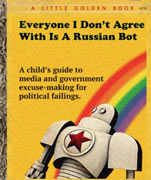|
Welcome goonlings to the Awful Book of the Month! In this thread, we choose one work of Resources: Project Gutenberg - http://www.gutenberg.org - A database of over 17000 books available online. If you can suggest books from here, that'd be the best. SparkNotes - http://www.sparknotes.com/ - A very helpful Cliffnotes-esque site, but much better, in my opinion. If you happen to come in late and need to catch-up, you can get great character/chapter/plot summaries here.  For recommendations on future material, suggestions on how to improve the club, or just a general rant, feel free to PM me. For recommendations on future material, suggestions on how to improve the club, or just a general rant, feel free to PM me.  Past Books of the Month [for BOTM before 2016, refer to archives] 2016: January: Three Men in a Boat (To say nothing of the Dog!) by Jerome K. Jerome February:The March Up Country (The Anabasis) of Xenophon March: The Name of the Rose by Umberto Eco April: Plain Tales from the Hills by Rudyard Kipling May: Temple of the Golden Pavilion by Yukio Mishima June:The Vegetarian by Han Kang July:Lud-in-the-Mist by Hope Mirrlees August: Pale Fire by Vladimir Nabokov September:Siddhartha by Herman Hesse October:Right Ho, Jeeves by P.G. Wodehouse November:Kitchen Confidential by Anthony Bourdain December: It Can't Happen Here by Sinclair Lewis 2017: January: Mother Night by Kurt Vonnegut February: The Plague by Albert Camus March: The Dispossessed by Ursula K. LeGuin April: The Conference of the Birds (مقامات الطیور) by Farid ud-Din Attar May: I, Claudius by Robert Graves June: Salt: A World History by Mark Kurlansky July: Ficcionies by Jorge Luis Borges August: My Life and Hard Times by James Thurber September: The Peregrine by J.A. Baker October: Blackwater Vol. I: The Flood by Michael McDowell November: Aquarium by David Vann December: Sir Gawaine and the Green Knight [Author Unknown] 2018 January: Njal's Saga [Author Unknown] February: The Sign of the Four by Arthur Conan Doyle March: Lincoln in the Bardo by George Saunders April: Twenty Days of Turin by Giorgio de Maria May: Lectures on Literature by Vladimir Nabokov June: The Electric Kool-Aid Acid Test by Tom Wolfe July: Warlock by Oakley Hall August: All Creatures Great and Small by James Herriott September: The Magus by John Fowles October: I'll Be Gone in the Dark by Michelle McNamara November: Arcadia by Tom Stoppard December: Christmas Stories by Charles Dickens 2019: January: Roadside Picnic by Arkady and Boris Strugatsky February: BEAR by Marian Engel March: V. by Thomas Pynchon April: The Doorbell Rang by Rex Stout Current:  https://www.youtube.com/watch?v=uqXVAo7dVRU Thinking, Fast and Slow by Daniel Kahneman Book available here: https://www.amazon.com/dp/B00555X8OA/ref=dp-kindle-redirect?_encoding=UTF8&btkr=1 About the book: quote:Thinking, Fast and Slow is a best-selling[1] book published in 2011 by Nobel Memorial Prize in Economic Sciences laureate Daniel Kahneman. It was the 2012 winner of the National Academies Communication Award for best creative work that helps the public understanding of topics in behavioral science, engineering and medicine.[2] quote:In the book's first section, Kahneman describes two different ways the brain forms thoughts: quote:Kahneman developed prospect theory, the basis for his Nobel prize, to account for experimental errors he noticed in Daniel Bernoulli's traditional utility theory.[11] According to Kahneman, Utility Theory makes logical assumptions of economic rationality that do not reflect people's actual choices, and does not take into account cognitive biases. https://en.wikipedia.org/wiki/Thinking,_Fast_and_Slow About the Author(s) quote:Daniel Kahneman (/ˈkɑːnəmən/; Hebrew: דניאל כהנמן; born March 5, 1934) is an Israeli-American psychologist and economist notable for his work on the psychology of judgment and decision-making, as well as behavioral economics, for which he was awarded the 2002 Nobel Memorial Prize in Economic Sciences (shared with Vernon L. Smith). His empirical findings challenge the assumption of human rationality prevailing in modern economic theory. https://en.wikipedia.org/wiki/Daniel_Kahneman Themes The limits of what we know; limits of our ability to understand ourselves; the absolute-scale idiocy of even relatively intelligent people Pacing Read as thou wilt is the whole of the law. That said, I may approach this as a bit of a "let's read" going through the book chapter by chapter if I have time. If I don't and other people want to take that and run with it, feel free. Please post after you read! Please bookmark the thread to encourage discussion. References and Further Reading quote:The Irony Effect: How the scientist who founded the science of mistakes ended up mistaken. https://slate.com/technology/2016/12/kahneman-and-tversky-researched-the-science-of-error-and-still-made-errors.html Here's the replication analysis by Schimmack -- basically, the errors seem to all focus around the priming studies turning out to not be replicable: quote:Schimmack and Brunner (2015) developed an alternative method for the estimation of replicability. This method takes into account that power can vary across studies. It also provides 95% confidence intervals for the replicability estimate. The results of this method are presented in the Figure above. The replicability estimate is similar to the R-Index, with 14% replicability. However, due to the small set of studies, the 95% confidence interval is wide and includes values above 50%. This does not mean that we can trust the published results, but it does suggest that some of the published results might be replicable in larger replication studies with more power to detect small effects. At the same time, the graph shows clear evidence for a selection effect. That is, published studies in these articles do not provide a representative picture of all the studies that were conducted. The powergraph shows that there should have been a lot more non-significant results than were reported in the published articles. The selective reporting of studies that worked is at the core of the replicability crisis in social psychology (Sterling, 1959, Sterling et al., 1995; Schimmack, 2012). To clean up their act and to regain trust in published results, social psychologists have to conduct studies with larger samples that have more than 50% power (Tversky & Kahneman, 1971) and they have to stop reporting only significant results. We can only hope that social psychologists will learn from the train wreck of social priming research and improve their research practices. https://replicationindex.com/category/thinking-fast-and-slow/ quote:What the blog gets absolutely right is that I placed too much faith in underpowered studies. As pointed out in the blog, and earlier by Andrew Gelman, there is a special irony in my mistake because the first paper that Amos Tversky and I published was about the belief in the “law of small numbers,” which allows researchers to trust the results of underpowered studies with unreasonably small samples. We also cited Overall (1969) for showing “that the prevalence of studies deficient in statistical power is not only wasteful but actually pernicious: it results in a large proportion of invalid rejections of the null hypothesis among published results.” Our article was written in 1969 and published in 1971, but I failed to internalize its message. Kahneman, posting on replication index : https://retractionwatch.com/2017/02/20/placed-much-faith-underpowered-studies-nobel-prize-winner-admits-mistakes/ Kahneman's full post: https://replicationindex.com/2017/02/02/reconstruction-of-a-train-wreck-how-priming-research-went-of-the-rails/comment-page-1/#comment-1454 quote:A bit over four years ago I wrote a glowing review of Daniel Kahneman’s Thinking, Fast and Slow. I described it as a “magnificent book” and “one of the best books I have read”. I praised the way Kahneman threaded his story around the System 1 / System 2 dichotomy, and the coherence provided by prospect theory. https://jasoncollins.blog/2016/06/29/re-reading-kahnemans-thinking-fast-and-slow/ Other interesting behavioral psych books: Nudge: Improving Decisions About Health, Wealth, and Happiness https://www.amazon.com/Nudge-Improv...SZ3F2TWYVZ2TG1V Influence: The Psychology of Persuasion https://www.amazon.com/Influence-Ps...SZ3F2TWYVZ2TG1V Predictably Irrational, Revised and Expanded Edition: The Hidden Forces That Shape Our Decisions https://www.amazon.com/dp/B002C949KE/ref=dp-kindle-redirect?_encoding=UTF8&btkr=1 Final Note: Thanks, and I hope everyone enjoys the book!
|
|
|
|
|

|
| # ? Apr 28, 2024 15:14 |
|
Gosh darn it you posted all the corrections stuff I was gonna post vvvvv: they're ok but not my strongest work Discendo Vox fucked around with this message at 03:05 on May 2, 2019 |
|
|
|
Vox has some good and accessible articles on the replication crisis. Here are a couple that are worth reading: More social science studies just failed to replicate. Here’s why this is good. What psychology’s crisis means for the future of science
|
|
|
|
I wanted to read this a few weeks ago but I didn't get past page 70 or so. Is the entire book written like a self help book where every little facet of his theory is explained ten times in a row with five almost identical examples? If that's the reason it has 500 pages I definitely won't read all of them.
|
|
|
cebrail posted:I wanted to read this a few weeks ago but I didn't get past page 70 or so. anilEhilated fucked around with this message at 15:37 on May 2, 2019 |
|
|
|
anilEhilated posted:It's basically psychology aimed at the Average Joe and the style reflects that, yeah. That being said, it's definitely way above self-help stuff. I'd say it's worth giving a chance. yeah, the difference here is that it isn't just some dude's self-help bullshit; it's (mostly) confirmed scientific theory, backed up with studies and evidence. The goal isn't to teach you Core Wisdom for Life or anything, it's just to describe how everyone's brain works. It ends up being, effectively, a user's manual for your brain, a detailed description of how your brain works and where the points of failure are in people's thinking processes. The reason I ended up picking this one is that I actually think it's an important book for people to read. One of the most important life lessons anyone can learn is that everyone, all human beings, including they themselves personally, is extremely bad at thinking. We're all just sacks of hamburger that learned a few heuristic thinking tricks we use to stumble and guess our way through our days. This was a book I found both very humbling and very freeing: on the one hand, we're all idiots; on the other, it's ok, we're all idiots.
|
|
|
|
|
It's a really good book and it's a shame a chunk of the "thinking fast" part uses the "sexy" priming stuff which was largely unethical research / bullshit. Kahneman / Tversky heuristics work were probably the most important cognitive psychology stuff done in recent times.
|
|
|
|
I read this about 6 years ago - it's amazing. No self-help here, it presents the evidence based work of a Nobel Prize winner - and tells you nothing about what to do with that information. I rarely ever re-read a book. I've been really wanting to re-read this one, but have always put that off in favour of making progress on my Want to Read list... I picked it up last night and started re-reading thanks to BOTM.
|
|
|
|
Actually - I'm thinking of getting it on my Kindle because my printed copy is a bit out of reach right now - that link does point to the revised edition, right? (Because the Amazon page says 2011)
|
|
|
|
|
I'm still not clear that there is in fact a revised edition. I think we're gonna have to police the mistakes ourselves.
|
|
|
|
|
Somebody might rise to that challenge and comb through each and every mention, but if you want a HEURISTIC: if it is "cool" social priming that might get a blurb in mainstream journalism (say, a 60 second science podcast), it doesn't replicate.
|
|
|
|
pangstrom posted:Somebody might rise to that challenge and comb through each and every mention, but if you want a HEURISTIC: if it is "cool" social priming that might get a blurb in mainstream journalism (say, a 60 second science podcast), it doesn't replicate. the "thinking about the elderly makes people walk slower" study was one i remember being particularly silly
|
|
|
|
Apsyrtes posted:I read this about 6 years ago - it's amazing. No self-help here, it presents the evidence based work of a Nobel Prize winner - and tells you nothing about what to do with that information. the nobel prize in economics isn't even a real nobel prize.
|
|
|
|
A human heart posted:the nobel prize in economics isn't even a real nobel prize. It's administered by the Nobel Foundation, listed on their website under the section "Nobel Prizes and Laureates," with the others and awarded by the Royal Swedish Academy of Sciences just like the Nobel Prize for Physics and the Nobel Prize for Chemistry - at the same time in the same ceremony even. It is commonly referred to by most people as "The Nobel Prize for Economics" --- so.... Is there a heuristic in this book concerning pedantry? Good Book. Not Self-Help. Written by someone with real credentials, not a blogger. Better?
|
|
|
|
A human heart posted:the nobel prize in economics isn't even a real nobel prize.
|
|
|
|
I'm really sorry, y'all, I could've sworn he released a revised version with an amended foreword and the offending material stripped out. When I dig up my copy I'll try to flag all the offending studies.
|
|
|
Ok, as I go through and re-read I'm going to highlight particular passages:quote:To appreciate the autonomy of System 1, as well as the distinction between impressions and beliefs, take a good look at figure 3. This one is from the very beginning, where he's introducing the concepts of "system 1" (reflexive thought) and "system 2" (conscious thought). For me at least, this little passage here was one of the first paradigm shift moments I had reading this book. Before, I'd always assumed that biases were correctable; that with proper education and training, people could overcome them. Turns out, that's wrong! People's brains are bad at thinking; our biases and intellectual reflexes are not only limiting, they are more limiting than we are capable of correcting, even when we are consciously trying to correct them. We are all, all of us, always, much dumber than we are even capable of correcting for. No matter what we tell ourselves as we look at the two lines, one will always look shorter and the other longer! On the other hand, though, this is another one of those areas where there's more to the example than we're getting in the book: quote:Research has shown that perception of the Müller-Lyer illusion can vary. Around the turn of the 20th century, W. H. R. Rivers noted that indigenous people of the Australian Murray Island were less susceptible to the Müller-Lyer illusion than were Europeans.[4] Rivers suggested that this difference may be because Europeans live in more rectilinear environments than the islanders. Similar results were also observed by John W. Berry in his work on Inuit, urban Scots, and the Temne people in the 1960s.[5] https://en.wikipedia.org/wiki/M%C3%BCller-Lyer_illusion Turns out, the muller-lyer illusion is a white people problem! Of course, this doesn't change its usefulness as an example for Kahneman's purposes -- our System 1's have just been trained in such a way that they respond to this illusion, perhaps from growing up in "carpentered environments" -- but still! Maybe we can correct our biases, it just might take a LOT more effort --- not just a matter of thinking in the moment, but long-term re-training of our unconscious reflexes. So maybe a better world is possible.
|
|
|
|
|
I keep wondering, as I read through this, what results are contingent on culture, and which are universally human responses. Like the experiments on priming with images of money; is it specifically money? Are there other objects that give the same responses? Is there some people, cultures, condition that priming isn't as effective?
|
|
|
killer crane posted:I keep wondering, as I read through this, what results are contingent on culture, and which are universally human responses. Like the experiments on priming with images of money; is it specifically money? Are there other objects that give the same responses? Is there some people, cultures, condition that priming isn't as effective? Pretty much all the priming stuff we can discount as at least not *proven* yet. Some of it might be accurate but studies of good enough quality have yet to be done to confirm or disprove. But yeah, another lurking general bias in psychology is that most of the core studies are based on studies of grad students at big western universities and that is not a diverse population.
|
|
|
|
|
Yep. Back when I was in college, an oft-repeated joke among the lecturers was that psychology is the study of mind of mice and psychology students.
|
|
|
|
|
I read this in 2011. One of minor cute parts I remember is the example of how, because system 2 grabs resources, you can have a conversation while walking, but if you need to really engage your brain you stop walking. More substantially, ISTR a part about how using system 2 is exhausting, and how oppressed people (read: ppl w/ shittier lives) have to engage it more just to navigate their day to day, and so they're already more exhausted by the time they get to school or work when they need to use system 2 to improve themselves or earn money. I believe a study was cited where people doing mentally strenuous tests do better if they drink a sugary drink right beforehand. (Of course I'm not sure at all if that study is worth anything, now.)
|
|
|
|
you should start with the basic assumption that no psychology or social science paper is worth anything
|
|
|
|
quote:A disturbing demonstration of depletion effects in judgment was recently reported in the Proceedings of the National Academy of Sciences. The unwitting participants in the study were eight parole judges in Israel. They spend entire days reviewing applications for parole. The cases are presented in random order, and the judges spend little time on each one, an average of 6 minutes. (The default decision is denial of parole; only 35% of requests are approved. The exact time of each decision is recorded, and the times of the judges’ three food breaks—morning break, lunch, and afternoon break—during the day are recorded as well.) The authors of the study plotted the proportion of approved requests against the time since the last food break. The proportion spikes after each meal, when about 65% of requests are granted. During the two hours or so until the judges’ next feeding, the approval rate drops steadily, to about zero just before the meal. As you might expect, this is an unwelcome result and the authors carefully checked many alternative explanations. The best possible account of the data provides bad news: tired and hungry judges tend to fall back on the easier default position of denying requests for parole. Both fatigue and hunger probably play a role. Think about what this says about our legal system. If this study is valid, then Legal decisions aren't governed by laws or reasoning; they're governed by whether or not the judge has eaten or napped within the past few hours! On the other hand, quote:Glöckner’s analysis doesn’t prove that extraneous factors weren’t influencing the judges, but he shows how the same effect could be produced by entirely rational judges interacting with the protocols required by the legal system. https://mindhacks.com/2016/12/08/rational-judges-not-extraneous-factors-in-decisions/ (The difference would appear to be whether or not the order of the cases chosen is truly random). Hieronymous Alloy fucked around with this message at 00:18 on May 9, 2019 |
|
|
|
Hieronymous Alloy posted:If this study is valid, then Legal decisions aren't governed by laws or reasoning; they're governed by whether or not the judge has eaten or napped within the past few hours! if
|
|
|
|
|
I should note that PNAS has a bit of a reputation as a dumping ground for academy researchers when they run studies that don’t turn out well; “P-values Not Accepted Somewhere”. It’s not uniformly garbage or anything, but should be read with caution, like most non-discipline outlets. Edit: this reputation was due to pnas’s parallel submission pipeline for nas members (which google tells me was partly reformed in 2017), but, again as a non-field-specific, big name journal , it has problems with really inconsistent review standards and headline chasing. Discendo Vox fucked around with this message at 20:03 on May 10, 2019 |
|
|
|
Freakinomics has done a couple shows about Kahneman / Tversky worth listening to. Also I think there is overlap with the work of McGilchrist specifically what he desribes in The Master and His Emissary. The biases inherent in system two may be as dangerous as those of system 1 particularly if system one is what let's us see the gestalt. Back when I was in grad school I produced a rough model (that I've posted in the trade thread) that the program head was particularly impressed with it, as the thinking nessisary to produce models of that type was what he was trying to teach with the program. He asked how I had come up with it. The real answer was, I saw it and merely put it on paper. But he wanted a system 2 / emissary style procedure that I had used to create it. I gave him a half assed one. Another thing, the feeding the probation board study came up. Something one sees in a lot of cultures is that one must feed the guest before business is discussed. I encounter this a lot boarding merchant vessels with a large diversity of crew nationalities. It could be a simple as coffee to a full multi course meal ( followed by tea) or even alcohol. The very question of feeding the probation board is a good illustration of the system 1 / master vs the system 2 / emissary. It's plainly obvious this cultural practice to feed the other likely is functional. It's also very hard to really prove experimentally. In that word "experimentally" I think we can why the division between these two thinking systems is going to have huge far ranging consequences. I'd also caution the "pfft social sciences" crowd. Right now these types of mind problems are being tested experimentally with truly massive datasets on social media platforms. My understanding is that there are starting to be robust repeatable results for some of these questions.
|
|
|
There was one particular part of this book that I wanted to talk about before the end of the month because I think it's actually an extremely important life lesson -- well, this book is full of those, but this one in particular is particularly important (that's the joke). I'll quote:quote:
This is born out by lots of additional evidence and studies. The same data on people returning to baseline happiness after about six months turns out to also be true for lottery winners. For most of us most of the time, this, too, shall pass. What matters is how you react in the moment. Hieronymous Alloy fucked around with this message at 02:46 on May 31, 2019 |
|
|
|
|

|
| # ? Apr 28, 2024 15:14 |
|
Next months' thread maybe a little late getting up but it will be 1491: A History of the Americas Before Columbus.
|
|
|
|





























